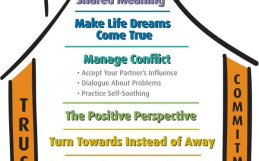Rebuilding Bridges: Nurturing Your Relationship After a Fight
In every relationship, disagreements and fights are bound to happen. However, what sets successful couples apart is their ability to repair and strengthen their bond after the storm has passed. Drawing upon insights from Gottman Method Couples Therapy, I will explore the importance of repair in relationships and provide practical strategies to help you approach your partner in the aftermath of a fight.
Why Repair Matters:
Many couples mistakenly believe that the end of a fight signifies the end of the issue. However, unresolved conflicts can accumulate and erode the emotional connection between partners over time. The Gottman Method emphasizes the significance of repair, as it plays a vital role in deepening intimacy, restoring trust, and fortifying the foundation of a resilient relationship. By embracing the principles of repair, couples can nurture their bond and create a secure and lasting connection.
Approaching Your Partner for Repair:
1. Create a Safe Space: Choose a time and place where both partners can feel comfortable and relaxed. Ensure minimal distractions and create an atmosphere that encourages open and honest communication.
2. Express Your Intentions: Start the conversation by expressing your genuine desire to repair and rebuild the relationship, incorporating the Gottman Method’s emphasis on fostering a “we” mentality. Make it clear that your goal is not to blame or win the argument but to work together as a team.
Example: “I want you to know that my intention here is not to place blame or continue the fight. I genuinely care about our relationship, and I believe that together we can find a way to heal and grow from this experience.”
3. Active Listening: Practice empathy and strive to understand their feelings, needs, and concerns without interrupting or becoming defensive. Try to summarize what they are trying to tell you and validate their perspective to demonstrate genuine understanding.
Example: “What you are telling me is that I was not trying to understand where you are coming from, and this really hurt you. I can totally understand why that would have made you frustrated. I apologize for not considering your point of view.”
4. Take Responsibility: Acknowledge your own role in the conflict, expressing genuine remorse for any hurtful behaviour. Demonstrate your commitment to growth and change by offering a sincere apology and a willingness to make amends.
Example: “I realize now that my reaction was unfair and hurtful. I am really sorry that I hurt your feelings, and I want to make things right. I will work on improving my responses in the future.”
5. Find Common Ground: Look for areas of agreement or shared values that can help bridge the gap between you and your partner. Shift the focus towards finding solutions and working collaboratively to meet both of your needs.
Example: “Despite our differences, we both want a loving and supportive relationship. Let’s work together to find a compromise that honours both of our perspectives.”
6. Develop a Plan: Collaboratively discuss ways to prevent similar conflicts in the future, such as improving communication, establishing boundaries, and addressing underlying issues. Explore strategies that resonate with both partners to promote ongoing growth and understanding.
Example: “I suggest we set aside dedicated time each week to discuss any concerns or frustrations before they escalate. This way, we can address issues proactively and prevent them from building up. It will be an opportunity for us to connect and understand each other better.”
Repairing the bond after a fight is an important compotent of maintaining a healthy and thriving relationship. Firstly, by creating a safe space, couples can establish an environment conducive to open communication. Additionally, actively listening to each other’s perspectives enables a deeper understanding of the underlying issues. Taking responsibility for one’s actions further contributes to the healing process. Moreover, finding common ground helps bridge the gap and rebuild trust. Lastly, developing a plan together demonstrates a shared commitment to growth and improvement.
Ultimately, the path to repair is paved with empathy, humility, and a steadfast commitment to nurturing the connection that brought the couple together in the first place.
I wish you all the best.




